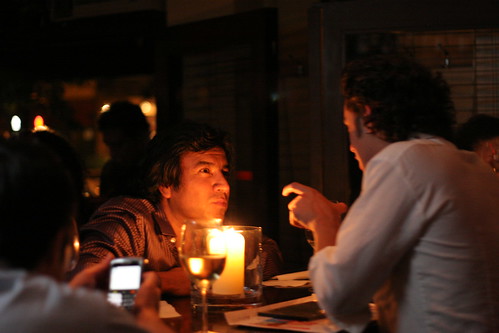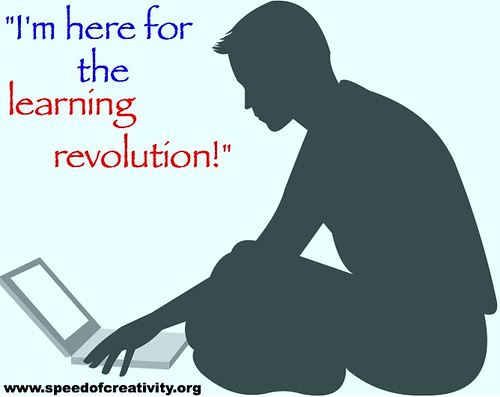In her June 21, 2007, article “Education: Connecting the Lonely Profession” for WorldChanging, Suzie Boss discussed how many teachers seem to be stuck in professional learning and interaction behaviors which resemble “parallel play” for young children. She wrote:
Roland Barth, founding director of the Principals’ Center at Harvard University suggested in Educational Leadership last year (March 2006) that too many teachers are still stuck in a grown-up version of “parallel play.” It’s that stage of early childhood marked by little peer interaction. He explains: “The abiding signature of parallel play in education is the self-contained classroom, with the door shut and a piece of artwork covering that little pane of glass. The cost of concealing what we do is isolation from colleagues who might cause us to examine and improve our practices.” Yet, he adds, “If one day we educators could only disclose our rich craft knowledge to one another, we could transform our schools overnight.”
With three young children of our own, my wife and I have definitely seen this process in which kids eventually move beyond playing in the same room BY each other but not WITH each other, to a point where they are really playing TOGETHER. This is a developmental process, but also one in which the encouragement of a peer can be critical. I’m positive our third child is much more advanced in her imaginative play because of the modeling and influence of her older siblings. Peers influence peers in powerful ways, at young but also at older ages.
I connect this with teacher professional development and ongoing growth in the following way: Please do NOT underestimate the VERY powerful and influential role which you have and will have on the other teachers in your own context. If there was a single message I learned in the three years I worked with the Texas Technology Leadership Academy for Superintendents and Principals (producing a series of 11 video interviews with past participants) it was that perceptual change most often happens when PEERS INFLUENCE PEERS. In the context of educator professional development and growth, we don’t want parallel play. “Play” is in fact desirable in many contexts (including uses of new technology tools) but these activities need to be interactive and collaborative, rather than isolated and “in parallel.”
I am convinced it is vital that we find ways to continue connecting as professional educators with each other in face-to-face meetups as well as online, virtual venues. Growing professional learning networks like the K-12 Online Conference, Classroom 2.0, Women of Web 2.0, The NECC 2008 Ning, and our own Celebrate Oklahoma Voices digital storytelling project learning community are perfect places for educators to connect with each other on an ongoing basis. These virtual communities gain strength and synergy when face-to-face meetups are possible, and allow for plenty of interaction and fun. That’s the reason I’m looking forward to EduBloggerCon San Antonio in a few short weeks! 🙂
The following Creative Commons licensed image is one of my favorites to use in presentations about school change:
I use this image as a backdrop for the statement, “Conversations change us.” When we think about school change, at both small and large levels, I think we need to be thinking about conversations. How are we serving as local catalysts for conversations about blended learning, authentic assessment, project-based learning, and 21st century literacy skills in our own local contexts? These conversations need to take place with parents, with fellow teachers, with librarians, with administrators, with community members, with board members, and with students. We need to find ways to DISCOURAGE “parallel play” when it comes to teaching and learning, and instead foster conversations with our peers and educational constituents about COLLABORATION on an ongoing basis.
In a comment to Suzie’s article, mrc notes that the organizational structure of our schools keeps teachers isolated in many cases, and that we should not look to blogging as “a panacea.” While I certainly agree there are no panaceas when it comes to the challenges we face in education and as educators, I also believe there has never been a better day to CHOOSE to be a connected educator than TODAY. Web 2.0 technologies mean many things to many people, but as Suzie notes in her article, one of the most important things they mean to a growing number of educators (including you and me, I’m sure) is that we are not alone in our profession and in our professional learning journeys. Whatever your context, whatever your geographic location, whatever your age, whatever your content area, whenever you are in time– We now have the opportunity thanks to these digital information networks which connect us to NEVER BE ALONE.
Isolation is a bad thing. That is why some adults make kids go sit in the corner by themselves, and criminals are sometimes punished with solitary confinement. As human beings, we are wired to be social and be connected. Certainly there are important times and places for DISCONNECTING, but in general most people are happier and more productive when they are safely CONNECTED with each other.
I think I’ll try and close this post with a trite but appropriate clincher. Friends don’t let friends teach alone. Or, how about: Just say no to parallel play in professional development. Are these attempts at humor silly? I’m sure they are. But you get the idea. We need to take ACTION based on what we know about the POWER and INFLUENCE we have on our peers and others in our own educational contexts. Let us remember and heed the prophetic words of Margaret Meade:
Never doubt that a small group of thoughtful, committed citizens can change the world. Indeed, it’s the only thing that ever has.
When you hear the pessimists, the naysayers, the doomsday prophets, and the “yeah-buts” tell you it is all hopeless, schools will never change, remember this: John Dewey didn’t have the opportunity to write and read blogs. Neither did Paulo Freire or John Holt. But we do. Our connected conversations and communications already ARE changing the world, because they are changing our practices. We are the learning revolution.
Thanks to the ever thoughtful and innovative Clay Burell for bringing Suzie’s article to my attention. 🙂
Technorati Tags:
learning, professionaldevelopment, teachers, isolation, reform, change, leadership
If you enjoyed this post and found it useful, subscribe to Wes’ free newsletter. Check out Wes’ video tutorial library, “Playing with Media.” Information about more ways to learn with Dr. Wesley Fryer are available on wesfryer.com/after.
On this day..
- Coding with Hopscotch and Visual Notes with iPads – 2014
- Superb Teachers, What makes you tick? – 2012
- Successful New Home Router Configuration for Videoconferencing, Dynamic DNS and OpenDNS Content Filtering – 2009
- links for 2008-06-18 – 2008
- Prepare now for the 10,000+ channel future – 2007
- Greetings from Anaheim – 2007
- Great first weekend in Edmond – 2006




Comments
5 responses to “Are teachers in your building parallel players?”
Hi Wesley,
I really enjoyed the post and just want to underscore your point about change happening through conversations.
As a management consultant, I view organizations as networks of conversations, through which people make sense of their world and decide how they are going to act. Outcomes emerge from the interplay of these formal and – most importantly – INFORMAL conversations, and the actions that flow from them. As the content and patterns of conversation change, so does the organization.
The more scope that individuals have for meaningful conversation with others, the more likely it is that novel perspectives will emerge and new behaviours take hold, as people coalesce informally around these emergent themes.
Hi Wes,
Thanks for your thoughtful comment. In the short year since I wrote this article, we’ve seen an explosion of opportunities for teachers to connect with peers. Classroom 2.0 was just a few months old last June. Now it’s an active community–a busy playground, if you will–of nearly 9,000 educators. Smaller scale but no less significant events are happening, too, such as Bud Hunt’s CyberCamp, Darren Draper’s Open PD, and the others you mention. I think we’re seeing a seismic shift away from top-down (mandated) professional development and toward a new conversation that’s initiated and directed by teachers, for teachers. Powerful–and sometimes playful, too.
I look forward to continuing this conversation at EduBloggerCon. Maybe a new session topic? See you there!
Thanks,
Suzie
This was a great article. Now that I retired from public school and teaching university level courses and some consulting work, was worried that I would be so isolated from other educational professionals. Through online chats and shows at edtechtalk, as well as connecting with others on Twitter, I feel less isolated. The need to stay connected is so important to me and I don’t want to just be a “parallel player!”
This whole area of teacher-to-teacher discourse fascinates me. I imagine the new ways we interact with each other has to rub off on how we interact with students, too. The shift to more student-centered, inquiry-based learning experiences requires new behaviors on our part– new patterns of dialogue practiced peer-to-peer can help us change the way we teach.
I’ve created a new page on my blog titled Learning Communities which includes links to many of these sites. If I’m missing some you really like please let me know by commenting! 🙂